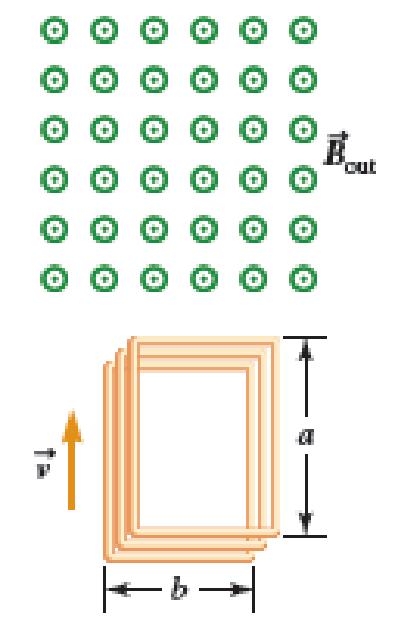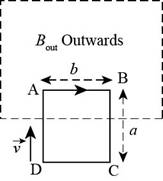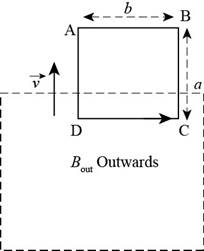
A Figure P32.74 shows an N-turn rectangular coil of length a and width b entering a region of uniform magnetic field of magnitude Bout directed out of the page. The velocity of the coil is constant and is upward in the figure. The total resistance of the coil is R. What are the magnitude and direction of the magnetic force on the coil a. when only a portion of the coil has entered the region with the field, b. when the coil is completely embedded in the field, and c. as the coil begins to exit the region with the field?

(a)
The magnitude and direction of the magnetic force on the coil when a portion of the coil enters the region of the field.
Answer to Problem 74PQ
The magnitude of the magnetic force on the coil when a portion of the coil enters the region of the field is
Explanation of Solution
Faraday’s law states that an emf is induced in a coil when the magnetic flux linked with the coil changes.
The direction of the induced emf is given by Lenz law. Lenz law states that the current induced in a circuit due to change or a motion in the magnetic field, opposes the change in flux and exerts a mechanical force opposing the motion.
A current carrying conductor experiences a force in a magnetic field. Thus, the conductor experiences a force due to the current induced in it.
A coil ABCD of
The coil moves with a constant velocity

Figure-(1)
Write the expression for the induced emf entering the magnetic field.
Write the expression for magnitude of the induced current in the coil.
Here,
Substitute equation (I) in the above equation to find
The flux entering the coil increases, as the coil enters the magnetic field. According to Lenz law, the current in the segment which enters the field, flows towards the right, from point A to point B.
Write the expression for force experienced by the segment due to current flowing in the coil.
According to the right hand screw rule, the force acts perpendicular to both the direction of current and the magnetic field. Therefore, the force acts downwards.
Write the expression for magnitude of the force.
Substitute equation (II) in the above equation to find
Conclusion:
Therefore, the magnitude of the magnetic force on the coil, when a portion of the coil enters the region of the field is
(b)
The magnitude and direction of the magnetic force on the coil when the coil is completely embedded in the field.
Answer to Problem 74PQ
The magnitude of the force on the coil when it is completely embedded in the magnetic field is
Explanation of Solution
As shown in Figure-(2), the coil is completely embedded in the field.

Figure-(2)
According to Faraday’s law of electromagnetic induction, the emf induced in the coil is
There is no current flow in the coil, when the induced emf is
Conclusion:
Therefore, the magnetic force on the coil when it is completely embedded in the magnetic field is
(c)
The magnitude and direction of the magnetic force on the coil as the coil begins to exit the region of the field.
Answer to Problem 74PQ
The magnitude of the magnetic force on the coil, when a portion of the coil exits the region of the field is
Explanation of Solution
The outward flux through the coil decreases, as the coil begins to exit the field. The current flows in the counter clockwise direction in the coil. The current flows from point D to point C as shown in figure-(3).

Figure-(3)
The magnitude of the current in the coil remains the same as it is when the coil enters the field, as the coil moves with the same constant speed. The direction of the current flowing in the coil, when it exits the field, is opposite to the direction of the current when the coil enters the field.
Write the expression for the current in the coil when it exits the magnetic field.
Write the expression for magnitude of the force experienced by the coil.
The magnitude of the force experienced by the coil, when it exits the field is same as, when it enters the field.
The force acts downwards along the plane of the paper.
Conclusion:
Therefore, the magnitude of the magnetic force on the coil, when a portion of the coil exits the region of the field is
Want to see more full solutions like this?
Chapter 32 Solutions
EBK PHYSICS FOR SCIENTISTS AND ENGINEER
- 6. A car drives at steady speed around a perfectly circular track. (a) The car's acceleration is zero. (b) The net force on the car is zero. (c) Both the acceleration and net force on the car point outward. (d) Both the acceleration and net force on the car point inward. (e) If there is no friction, the acceleration is outward.arrow_forward9. A spring has a force constant of 100 N/m and an unstretched length of 0.07 m. One end is attached to a post that is free to rotate in the center of a smooth. table, as shown in the top view in the figure below. The other end is attached to a 1kg disc moving in uniform circular motion on the table, which stretches the spring by 0.03 m. Friction is negligible. What is the centripetal force on the disc? Top View (a) 0.3 N (b) 3.0 N (c) 10 N (d) 300 N (e) 1000 Narrow_forward4. A child has a ball on the end of a cord, and whirls the ball in a vertical circle. Assuming the speed of the ball is constant (an approximation), when would the tension in the cord be greatest? (a) At the top of the circle. (b) At the bottom of the circle. (c) A little after the bottom of the circle when the ball is climbing. (d) A little before the bottom of the circle when the ball is descending quickly. (e) Nowhere; the cord is pulled the same amount at all points.arrow_forward
- 3. In a rotating vertical cylinder (Rotor-ride) a rider finds herself pressed with her back to the rotating wall. Which is the correct free-body diagram for her? (a) (b) (c) (d) (e)arrow_forward8. A roller coaster rounds the bottom of a circular loop at a nearly constant speed. At this point the net force on the coaster cart is (a) zero. (b) directed upward. (c) directed downward. (d) Cannot tell without knowing the exact speed.arrow_forward5. While driving fast around a sharp right turn, you find yourself pressing against the left car door. What is happening? (a) Centrifugal force is pushing you into the door. (b) The door is exerting a rightward force on you. (c) Both of the above. (d) Neither of the above.arrow_forward
- 7. You are flung sideways when your car travels around a sharp curve because (a) you tend to continue moving in a straight line. (b) there is a centrifugal force acting on you. (c) the car exerts an outward force on you. (d) of gravity.arrow_forward1. A 50-N crate sits on a horizontal floor where the coefficient of static friction between the crate and the floor is 0.50. A 20-N force is applied to the crate acting to the right. What is the resulting static friction force acting on the crate? (a) 20 N to the right. (b) 20 N to the left. (c) 25 N to the right. (d) 25 N to the left. (e) None of the above; the crate starts to move.arrow_forward3. The problem that shall not be named. m A (a) A block of mass m = 1 kg, sits on an incline that has an angle 0. Find the coefficient of static friction by analyzing the system at imminent motion. (hint: static friction will equal the maximum value) (b) A block of mass m = 1kg made of a different material, slides down an incline that has an angle 0 = 45 degrees. If the coefficient of kinetic friction increases is μ = 0.5 what is the acceleration of the block? karrow_forward
- 2. Which of the following point towards the center of the circle in uniform circular motion? (a) Acceleration. (b) Velocity, acceleration, net force. (c) Velocity, acceleration. (d) Velocity, net force. (e) Acceleration, net force.arrow_forwardProblem 1. (20 pts) The third and fourth stages of a rocket are coastin in space with a velocity of 18 000 km/h when a smal explosive charge between the stages separate them. Immediately after separation the fourth stag has increased its velocity to v4 = 18 060 km/h. Wha is the corresponding velocity v3 of the third stage At separation the third and fourth stages hav masses of 400 and 200 kg, respectively. 3rd stage 4th stagearrow_forwardMany experts giving wrong answer of this question. please attempt when you 100% sure . Otherwise i will give unhelpful.arrow_forward

 Principles of Physics: A Calculus-Based TextPhysicsISBN:9781133104261Author:Raymond A. Serway, John W. JewettPublisher:Cengage Learning
Principles of Physics: A Calculus-Based TextPhysicsISBN:9781133104261Author:Raymond A. Serway, John W. JewettPublisher:Cengage Learning Physics for Scientists and Engineers: Foundations...PhysicsISBN:9781133939146Author:Katz, Debora M.Publisher:Cengage Learning
Physics for Scientists and Engineers: Foundations...PhysicsISBN:9781133939146Author:Katz, Debora M.Publisher:Cengage Learning College PhysicsPhysicsISBN:9781938168000Author:Paul Peter Urone, Roger HinrichsPublisher:OpenStax College
College PhysicsPhysicsISBN:9781938168000Author:Paul Peter Urone, Roger HinrichsPublisher:OpenStax College Physics for Scientists and Engineers, Technology ...PhysicsISBN:9781305116399Author:Raymond A. Serway, John W. JewettPublisher:Cengage Learning
Physics for Scientists and Engineers, Technology ...PhysicsISBN:9781305116399Author:Raymond A. Serway, John W. JewettPublisher:Cengage Learning Glencoe Physics: Principles and Problems, Student...PhysicsISBN:9780078807213Author:Paul W. ZitzewitzPublisher:Glencoe/McGraw-Hill
Glencoe Physics: Principles and Problems, Student...PhysicsISBN:9780078807213Author:Paul W. ZitzewitzPublisher:Glencoe/McGraw-Hill





